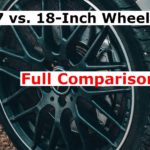18 vs. 19-Inch Wheels: Full Comparison
We all love bigger wheels and how they look on our vehicles. It is one of the easiest modifications to make as you can just buy them and put them on your car.
But maybe you haven’t experienced a larger wheel setup on your vehicle before and want to make the change. There are a few things you may need to consider before buying a new set of bigger wheels.
18 vs. 19-Inch Wheel? What’s Better?
18-inch wheels are slightly better for their overall use than the 19-inch wheels. Smaller wheel and tire combinations are better for daily use. 19-inch wheels may look better, but the 18-inch have more advantages.
Wheels sizes have their advantages and disadvantages in certain conditions. Looking at most of these conditions, the conclusion is that 18-inch wheels are the better choice.
But increasing from 18 to 19-inch wheels isn’t going to hurt the usage of your car. Let’s analyze this further in a few categories to decide which is best.
Also read: Are Cheap Tires Worth it? Are They Safe?
18 vs. 19-Inch Wheel: Fuel Consumption
The smaller 18s have a slightly better fuel economy. But if you drive on the highway a lot, this won’t matter as much.
Bigger wheels are heavier than smaller wheels. This means the rolling resistance is higher. More effort and fuel will be needed to get the car moving which will slightly decrease your fuel economy.
But if you do a lot of highway driving, this is negligible. Highway driving at higher speeds negates the decrease in fuel economy. Since the 19s are only an inch more, the difference won’t be felt on the highway.
18 vs. 19-Inch Wheel: Smooth Ride
Looking for a smoother ride?
The 18-inch wheels will offer a smoother ride experience than the 19s. The tire sidewalls are thicker, which helps absorb bumps and road imperfections better.
Sizing up to a bigger wheel decreases the sidewall of your tires. Road imperfections and bumps are now felt more than the smaller-sized wheels.
Fancy new cars may have better suspension to deal with the bumps even with bigger wheels, but normal cars can’t. The 18-inch wheels are smaller and lighter, which immediately makes the car more comfortable.
19-inch wheels can’t cope with these bumps because road imperfections get transferred to the wheel easily. The sidewalls are smaller, which transfers the bumps more to the wheels than the tires, making the ride a bit harsher. For the 18s, the imperfections are transferred to the soft tires more, making the ride more comfortable.
Road noise is also more with the bigger wheels. Because of the aforementioned sidewall difference, the 19s make more noise when moving than the 18s. All these factors make the 18s a more comfortable wheels setup.
Also read: 18 vs. 20-Inch Wheels: Full Comparison & What’s Better
18 vs. 19-Inch Wheel: Grip and Traction
Grip levels between these wheels are minimal. Both will perform very well in similar conditions, either wet or dry. But the larger 19s may help provide a little more grip than the 18s.
Just increasing your wheel size alone will hardly affect your car’s grip. The contact patch remains mostly the same. If the width of the wheel also remains the same, the car will still have the same level of traction on dry, wet, and snowy surfaces.
In performance driving, this could be a little different. If the bigger wheels aren’t set up properly, they may cause a bit of understeer in the corners. The smaller wheels being lighter will turn more easily than the bigger, heavier wheels. But with the right setup, the grip/traction levels will remain fairly the same.
18 vs. 19-Inch Wheel: Braking
Braking distance just like traction is hardly affected by switching to a 19-inch wheel. The contact path is still similar, so applying the brakes will still slow your car down at the same distance.
Bigger wheels do affect braking distance as they are bigger and heavier. It would require a lot more force to slow the car down. 18s and 19s however have minimal rolling resistance between them. Braking is hardly affected between these wheel sizes.
Most new cars have bigger wheel options from the factory. These changes have been accounted for to make sure the cars break similarly. Only switching to a way bigger wheel size like 18 to 20s will braking start to be affected negatively.
18 vs. 19-Inch Wheel: Off-Road
In this category, without a doubt, the 18-inch wheels are the best option. Smaller wheels with bigger sidewalls have always been the go-to option for anyone that wants to go off-roading. The bigger the sidewall, the better your chances are of completing your journey.
Off-road trails are filled will uneven and very rough surfaces. A smaller wheel size with a bigger tire combo will help absorb the bad surfaces better. The bigger 19s will make you feel these rough surfaces more and make the ride very uncomfortable.
The risk of destroying your wheels is also higher. Since the 19s don’t have much sidewall, it is easier to curb and dent your wheels. Driving a little too fast on off-road surfaces can bend your wheels if they come in contact with rocks.
This is also evident with the off-road tires available. Anything above 18 inches, and you will struggle to find an off-road tire to put on your vehicle. Tire manufacturers know that bigger wheels mean more problems, so they usually make off-road tires for smaller wheel sizes.
Also read: Wider Car Tires: ALL Pros and Cons
18 vs. 19-Inch Wheel: Appearance
Bigger wheels look better than smaller wheels. The larger wheels show off the wheel designs better than the smaller ones. If you want good looks, the 19-inch wheels will look better and give your car a better stance than the 18s.
In the beginning, wheels were seen as part of a vehicle and most people would use the wheels that came with the car. But today, wheels add to the looks of a car, and a nice set of wheels will make your car look good. One of the first things people do when modifying their car is to get bigger wheels. But why is that?
Aesthetically, bigger wheels with the same design have always looked better than smaller wheels. 19-inch wheels or bigger will look better than 18-inch wheels.
We’ve seen this trend in car culture, from enthusiasts to rappers. To look good, bigger wheels will always get the job done.
Increasing to larger wheels makes your car look a bit beefier than stock. The wheel arches are filled, giving the car a more complete look than the smaller 18s. Reducing the wheel gap makes your car look a bit aggressive and lower than it is without the need to lower the vehicle.
Sports car manufacturers always go for a bigger wheel setup for appearance. Cars in recent years have also come standard with bigger wheels. Some of them even come standard with 22-inch wheels, and they always look better than the ones with the 20s or even 18s. If you see both cars side by side you may think something is wrong with the car with the smaller wheels.
18 vs. 19-Inch Wheel: Tire Wear
The lifespan of your tire will be cut a little short with bigger 19-inch wheels. Since the sidewalls are smaller, taking corners or making turns will exert a little more force on the sides of the tires, making them wear out more.
It’s not just the tire profile, but also the added weight. The weight, size, lower tire profile all affect the lifespan of your tire. Smaller wheels have larger sidewalls and more room to soften/cushion your ride with less force being applied to the tire.
But with bigger wheels, the tire profile changes. When making turns the car has to make do with the available sidewall left, which wears out the tires more.
For long-lasting tires, the 18-inch wheels are better.
Also read: 19 vs. 20-Inch Wheels: Full Comparison & What’s Better
18 vs. 19-Inch Wheel: Price
The 19-inch tires are always more expensive than the 18s. That’s because they are bigger, which means they require more time to get them done, more metal is being used, and they are more popular, which boosts their prices.
Bigger wheels will always cost more than smaller wheels. The tires needed to fit these wheels are also a bit more expensive. More metal is used in the manufacturing process, which takes more time to get each wheel done. Bigger wheels are in higher demand lately, so it has led to a bit of a price boost.
In the end, wheels are a personal preference. If you can live with the compromises that come with bigger wheels, then go for it. Personally, I’d rather go for the 19s.
Below is a table comparing 18 and 19-inch wheels on a 2010 Volkswagen Golf.
Car and Driver test on a 2010 Volkswagen Golf
| Wheel Size | 18 inch | 19 inch |
| Price Per Wheel | $166 | $199 |
| Price Per Tire | $125 | $160 |
| Fuel Economy | 21.9 mpg | 21.1 mpg |
| Noise Level | 70 decibels | 71 decibels |
| Weight (+tire) | 51 lb | 54 lb |
| Braking 60-0 mph | 126 ft | 126 ft |
| Skidpad Grip | 0.89 g | 0.88 g |






